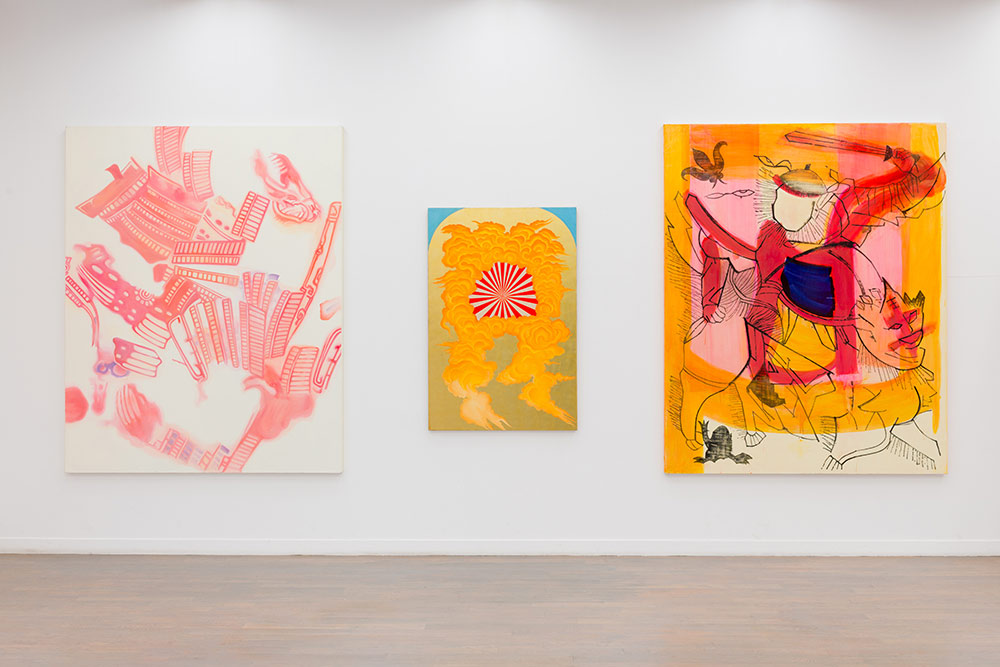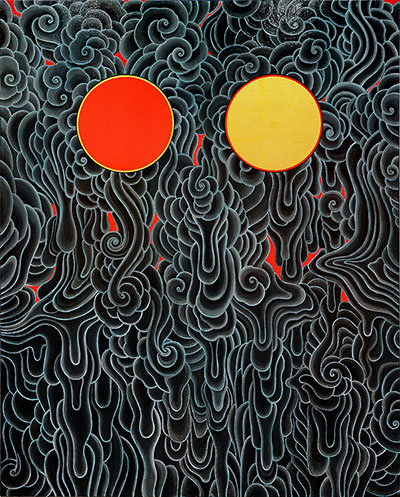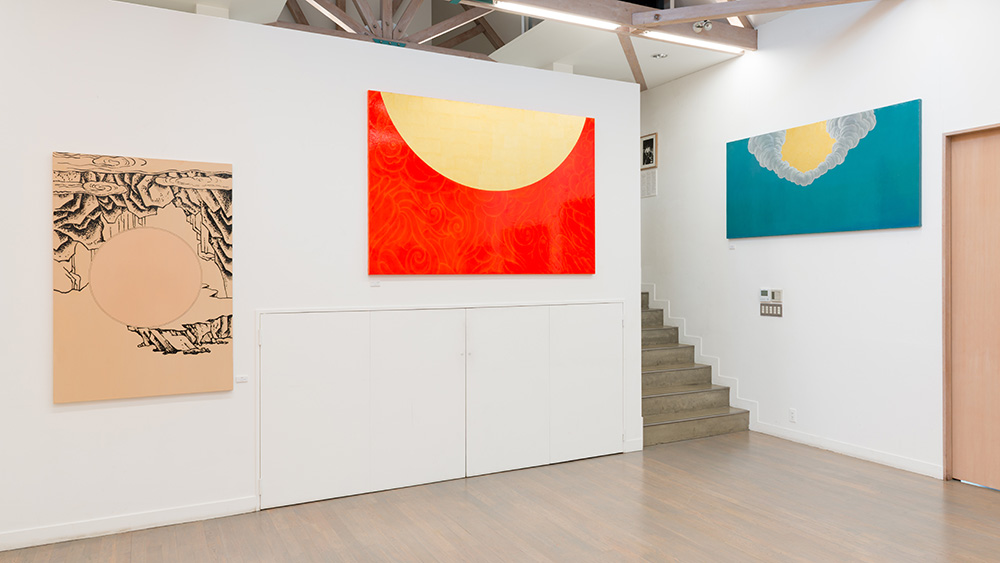
初 國 ~未生以前~
橋本 倫
2013年3月15日[金]- 5月19日[日]
10:00-18:00(入館は17:30まで)
毎週:月・火曜休館
入館料/通常料金 500円
■ オープニング・パーティー 3月16日(土)15:00~
■ 特別プログラム 5月6日(月・祝日)15:00~ アーティスト・トーク開催
初 國 ~未生以前~
橋本倫
この展覧会タイトルに、私は万感の思いを籠めている。先ずは、2011年に発生した東日本大震災との関わりで、二つ目は、斯かる自然の猛威に曝され続けてきたこの国土に於いて誕生したスサノオ神なる神格と、『古事記』編纂1300年記念という節目の年との関わりで、三つ目は、2006年6月20日に逝った縄文芸術評価の大詩人・宗左近こと古賀照一が見出した”怪奇面”との関わりで、そして最後は、この横須賀の地との関わりで。
2011年10月、私は横須賀に隣り合う北鎌倉で、「北溟」と名打った個展を行った。会場は、奥深い山中にある元寺院跡地に建てられたギャラリー・スペースで、そこは崖地からテラス状に迫り出し、北東へと舳先を向けていた。建物の空間は、偶然にも中世に出現した阿弥陀堂の構造を具え、私はそこで補陀落渡海と山越阿弥陀図のテーマが、東日本大震災に対する私の内的反応と絡み合う作品群を発表した。
船、又は丸木舟、そして洋上を進む霊柩のイメージ。
被災した福島の白水阿弥陀堂(平安時代末期)の空間構造は、偶然にも北鎌倉に於ける発表会場と瓜二つのものであり、そこでは常に、出帆と航海のイメージが纏わり憑いた。この航海のイメージには、あのヒルコ=蛭子=恵比寿=秦河勝のイメージ、弥勒船や空穂船のイメージが底に潜んでいた。
秦河勝は、壷(空)船に乗って漂い着いた先にあって、文明と共に大いなる災厄をも齎す存在と化したが、これは破壊神と創造神の二面を供える”大キニ荒ルヽ神”スサノオやアッポローンやシバの神格にそのまま通じるものだ。沿岸に破壊と豊漁を齎す海洋の神威は、海から上陸して沿岸部を混乱に陥れる伝説上の秦河勝や、福の神へと変貌したヒルコによっても代表されるが、これは、海洋渡航自殺が西方浄土での至福の転生に通じるという補陀落渡海の思想とも二重写しになってくる。
業ヲ子孫ニ譲リテ、世ヲ背キ、空舟ニ乗リ、西海ニ浮カビ給イシガ、播磨ノ国南波尺師ノ浦ニ寄ル。蜑(あま)人舟ヲ上ゲテ見ルニ、化シテ神トナリ給フ。当所近離ニ憑キ崇リ給シカバ、大キニ荒ルヽ神ト申ス。スナワチ大荒神ニテマシマス也。コレ、上ニ記ストコロノ、母ノ胎内ノ子ノ胞衣、「ちはやノ袖」ト申セルニ符合セリ。[胞衣ワスナワチ荒神ニテマシマセバ、コノ義合エリ]。ソノ後、坂越ノ浦ニ崇メ、宮造リス。(……)所ノ人、猿楽ノ宮トモ、宿神トモ、コレヲ申タテマツルナリ。コヽヲ以テモ、翁ニテマシマスト知ルベシ。サレバ翁ノ御事、大荒神トモ、本有ノ如来トモ、崇メタテマツルベキ也。
金春禅竹(1405~1471)『明宿集』
しかし、こうした文字化され、或いは仏教化された文脈の中に昇華されていく以前の、骨無く蠢くヒルコが持つ、謎めいた生物学的イメージが原形質の闇のように水中で渦巻く”久羅下那州多陀用弊流 (くらげなすただよえる)”そして”如葦牙因萌騰(あしかびの如くもえあがる)”構図こそ、本来、この国の土壌に豊かに根付いていた筈の根基のイメージであって、宗左近は、この点を奥底まで見抜いた稀代の目利きであった。
従来から、縄文芸術の最高峰を火焔土器群に置く視点は枚挙に遑無く、岡本太郎もその例外では無かった。しかし、宗は違った。彼はそれらを圧倒的に凌ぐ上位に、空前の名作、”怪奇面”を置き、その本質が”未生以前”にあると喝破した。これこそ、ヒルコの原型イメージであり、火焔土器という公式イメージに結実する以前の、混沌たる原型=アーケタイプに他ならない。
考古遺物たる”怪奇面”は、厳密に言えば、有孔鍔付土器の装飾の一部ではあるが、完全に独立した造形として成立し、彫塑芸術としても古今に比類無い。全世界でこのレヴェルの神秘的な作品を産み出した文明・文化は、管見の限り人類史上で日本以外に唯の一度も存在したことが無かった。日本は中国本土や朝鮮半島とは全く異なるタイプの、文字史以前の1万年に及ぶ芸術文化の絶頂が継続したのである。この事実は、現代に伝わり、尚も陸続と出土する縄文時代の偉大な作品群、とりわけ中期から後期にかけてのめくるめく渦巻き造形の徹底振りとその精密さを目の当たりにすれば、直ちに理解されよう。
もし、韓国人が絶えず口にしてやまないように、あらゆる文化のみならず人間までもが朝鮮半島から日本に伝わったのだとすれば、何故、こうした表現特徴を有する火焔土器片の一つすら半島から出土しないのか?数億点にも上ると推定される縄文土器の、それも絶頂期の名品に匹敵する彫塑遺品が、何故出土しないのか?不思議ではないか。日本人こそ、この点に思い至るべきである。『古事記』は、縄文時代に完成された神話学の文字記録化であって、縄文時代最後の文化遺産なのだ。

昭和56年10月から12月にかけて、横須賀市久里浜町8丁目にある伝福寺裏遺跡で発掘が行われた。これは、神明町に於ける市南部清掃工場建設のための下水道工事に伴う事前調査として行われたもので、この現場から、5500~5000年前のムクノキを刳り抜いて造った全長3mの丸木舟が出土した。 この船の出土地点は、当時、衣笠付近まで入り込んだ広い湾の入り口に位置しており、舟は、この湾内-古久里浜湾-を往来していたものと想われる。この舟は現在までのところ、神奈川県で発見された唯一の縄文時代の丸木舟であり、この舟のイメージが衣笠=平作にかけての古久里浜湾のイメージ、そして北鎌倉に於ける補陀落渡海と霊柩舟のイメージと結び付き、私を何か非常に深いところで符合するイメージ群によって海原のように満たした。そしてそれらが、古城址の存在する衣笠のイメージ、強弓を作り出した兵器製造集団の住まう土地であった矢部の史実、海洋民族としての三浦半島のイメージ等と複雑に化合し、干渉し合い、スサノオの荒御霊の神格へと収斂して行ったのであるが、東日本大震災により尋常ならざる衝撃を蒙った我々の精神にとっては、これらの絢爛たるイメージ群は、まるで秦河勝が籠った壷舟のように原初の一点へと帰せられ、総括されるべきものであった。その言葉、イメージこそ、国を肇(はじ)めること-「初國」-である。
絶えず原点に還り甦り続ける「初國」の無限の生成感を言挙げした男こそ保田與重郎、この文章を記した11月25日が三島由紀夫の命日と重なったことは今、偶然ではなく、何より衣笠/平作の地に在る「カスヤの森現代美術館」にて「初國」のテーマを言挙げすることは、尚のこと偶然ではない。
(平成24年11月25日 橋本 倫 記)

“Hatsukuni(Ceaselessly Regeneration)~Beyond the origins~ “
OSAMU HASHIMOTO
March15 (Fri) – May 19 (Sun) 2013
10:00 – 18:00 (Last admission 17:30)
Closed on Mondays and Tuesdays
Admission : 500 yen
“Hatsukuni(Ceaselessly Regeneration)~Beyond the origins~”
OSAMU HASHIMOTO
A commingling of emotions is put feeling into the appellation of this exhibition aforementioned.
Firstly, with relation to devastated earthquake in eastern Japan occurred in 2011. And the second, in the
intimate relationship between the anthropomorphic deity of Susanoh and just the 1300s anniversary of 『KOJIKI』(Japanese oldest history extant on the subject) compilation. The third, a close connection with the “Kaikimen”(=Mysterious earthen Mask)which is found by the great poet Koga Shouichi A.K.A. Sou Sakon who was quite outstanding as a connoisseur for JOMON-Ancient-Fine Arts in this Nation, but he died on June 20 in 2006. And the last, involving various factors in the land of Yokosuka.
On October in 2011, I held the one-man-show entitled 「Hokumei(=The Northern Hades)」in Kitakamakura where borders on Yokosuka in the west. The gallery space of this exhibition was prepared at the site of the demolished Buddhist temple. Terrace like this site was overhanging from the bluff and was headed for northeastward. The space structure of this gallery accorded coincidently with 「Amida-Doh(=Amitabha chapel)」that is new arrival in the Middle Ages of Japan.
I placed my works on display at this space. These piece of works included the religious themes derived from”Hudaraku-Tokai(=The Martyrdom Sea Voyage heading the Buddhist Western Paradise (=Hudara~Potala))”and “Yamagoe-Amida(=Amitabha crossing the mountain)”and these themes were combined with my inner reaction against the Earthquake aforementioned.
The image derived from the vessel or dugout, and the coffin that is sliding at sea.
The space structure of the Amitabha chapel「Shiromizu Amida-Doh」(the latter part of the Heian Period) in Fukushima Prefecture resemble the gallery space in Kitakamakura very closely. Around this space structure always conceive the image of departure and voyage, and these images arose from the serial images of Hiruko=Ebisu=Hatano-Kawakatsu(=they are mythological castaways), or the image category of vessels like Mirokubune or Utsubobune(=they are mythological derelict ships).
Hatano-Kawakatsu underwent a remarkable metamorphosis from the human being to the deity like Janus who brings disaster and blessed to the people at the land of his drifting ashore. Such like creative and disastrous deity as”great spirit going on the rampage”is bearing a striking resemblance to the deities like Susanoh, Apollo or Shiva. The providence or the might of the ocean has brought a rich haul and calamity to the cost is symbolized by the semi-legendary Hatano-Kawakatsu or metamorphosed Hiruko as the God of Wealth and Commerce. We can find double exposure thought in these mythological anecdotes, for instance, the Martyrdom Sea Voyage sudden complete reversal of the plot as the resuscitate at the Western Paradise.
”After handing over his duties to his progenies, he is turning his back on the world and is going on board Utsubobune(=mythological derelict ship). Through the west ocean, he washed ashore at the cost of Nanbashakushino-Ura located in Harima-no-Kuni. While the divers for abalones are fastening their eyes on this vessel, he was metamorphosed into the God. At the first stage of transfiguration, He was afflicting around the cost, so He was tendered honorific title of “great spirit going on the rampage”, namely, 「Ooh-Aragami(=Awe-inspiring Raging God)」.This (folk tale) aforesaid tallies with the fact that the “Ena(=placenta)”is called “Chihayano-Sode”[Ena(=placenta) id est. Aragami(=Raging God), therefore, accords with logical hypothesis].
Thereafter, He was sealed at the shrine located in Sakakoshino-Ura.・・・The residents around the shrine called it Sarugaku-no-Miya or Suku-shin with awe-stricken. Derived from this oral tradition, we should perceive the God aforesaid is Okina (=the God as venerable gentleman). On this account, we have to be an ardent admire of this sacred oral tradition of Okina, or Ooh-Aragami, or Nyorai (=Tathagata) as their true form.
Konparu Zenchiku (1405~1471) 『Meishuku-Shu (=The Anthology of Galaxy)』
Of course we already notice such like buddhismized context that is clearly specified in 『Meishuku-Shu』 take its rise in protoplasmic dark images has been striking root into the soil of this Nation, bearing a close resemblance to the biomorphic and mystical visions of invertebrate wriggling Hiruko (=like leech God) or visions of “Kuragenasu-tadayoeru (=drifting about at the mercy of the waves like medusas)”at once, of “Ashikabi-no-gotoku-moeagaru (=bursting into bud like grown marshes stems)”. Poet Sou Sakon was the extraordinary connoisseur who had the keen eye for these unfathomable images that forming the basis of context above-mentioned.
All are equal under holding the same opinion as regarding Kaen-Doki (=earthenware with ornamental carving like blaze shapes) as the greatest of all JOMON-Ancient-Fine Arts, including Okamoto Tarou.
But, Sou was not. He ranked the unexampled masterpiece”Kaikimen” higher than Kaen-Doki , and pointed it’s essential qualities is “Beyond the origins”. This is the very image just what archetype image of Hiruko.
Kaen-Doki can be compared to the public image, but “Kaikimen”is not. It is naked and chaotic image of archetype before the crystallization of Kaen-Doki just as the public image. Strictly speaking, “Kaikimen”as the archaeological relic is one of the fragment of a broken earthenware with mysterious gaping holes and ornamental carving like a brim. Notwithstanding this fact, “Kaikimen”is completely separated plastic fine art work as the sculpture that is unique in the world or through the ages. In my personal view, the peer of the work of “Kaikimen”is not found in this world. Japan had been achieved maintainable growth of the zenith of fine art more than 10,000 years through the prehistoric JOMON-Period. This artistic acme is absolutely different from China or Korea’s. We can promptly affirm this historic fact through the essence of the great JOMON-Ancient-Fine Arts (above all, from the middle period through late) with radiant and fascinating modeling of powerful spiral patterns. Koreans always said that not only Japanese civilization or culture but also all ethnic groups in this country have been derived from Korea, so there is no unique and any respectable culture in Japan. They follow Japan tenaciously and Japanese all culture and all fine arts have been criticized severely as being tawdry copies of great Korean culture. Exactly not! Why a fragment of JOMON-like earthenware has never been excavated from the prehistoric ruins has located in Korean peninsula? This is the undeniable historical fact. We Japanese international Nation have numerous supreme and great masterpieces of JOMON-Ancient-Fine Arts. But Koreans absolutely not! Japanese culture and civilization is not the degraded copies of Korean’s one. The essence of our culture and civilization are all derived from our selves and our realm, not from Korea. Their influence only operated on the surface(=top layer) of Japanese culture, not the basic layer. You must know it. Of course, Korean great culture is very different from China or Japan. Korea is Korea, not Japan. Japan is Japan, not Korea. Japanese oldest history 『KOJIKI』is the codification of the JOMON-mythology and the comprehensive last survey of it.
From on October through December in 1981, the Denpuku-ji ruins located in Kurihama in southern part of Yokosuka City were excavated. This excavation was held as the feasibility study for the drainage works in Shinmei-cho. A wooden canoe unearthed at the site for the construction of the garbage incineration plant.
This canoe had a total length of 3 meters and hollowed from a Mukunoki(=Aphananthe) trunk around 5500~5000 years ago. At the Jomon-period, the find site of it situated around the mouth of Ancient Kurihama-Bay that extended as far as Kinugasa and its environs. This only Jomon-dugout in which was dug in Kanagawa Prefecture always gives full scope to my religious and cosmic imagination. May be this dugout came and went on this ancient bay concealed the land of Kinugasa through Hirasaku around the Ancient Kurihama.
My imagination and inspiration were filled up by the deeply oceanic vision of “Hudaraku-Tokai “as the cosmic coffin vessel came flying from Kitakamakura. Furthermore, these complicated images have been combined with each other and in addition, have been got toward the image of the ruins of Kinugasa Castle or the Yabe settlement of the artisans who manufactured the high-performances bows, eventually, these gaudy images or visions stemmed from the genius loci of Miura Peninsula converge on Aramitama(=Raging Spirit) of the oceanic tribe’s deity of Susanoh.
We Japanese Nation are terribly shocked to experience of devastated earthquake in the East part of Japan and our health and nerves are in shreds. Our crushed nerves should be restored to life through the mythological derelict ships of Hatano-kawakatsu as the zero point.
Precisely, this image equal Hatsukuni (=Ceaselessly Regeneration). The man who indicated this inexperienced image was Yasuda Yojyuro, and he stressed that this image of Hatsukuni symbolized infinite generates.
This text of mine was finished writing 25 on November as the anniversary of Mishima Yukio, but there is no coincidence. Moreover, there are no any fancy meeting that my works exhibition entitled 「Hatsukuni」will be held at the「MUSEUM HOUSE OF KASUYA」in this genius of Kinugasa/Hirasaku
(On Nov.25 in 2012 Hashimoto Osamu)
Translation by Miho Ida